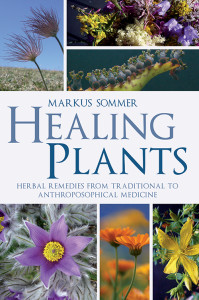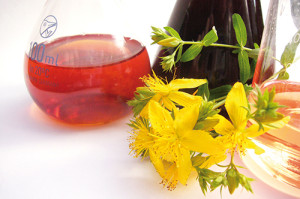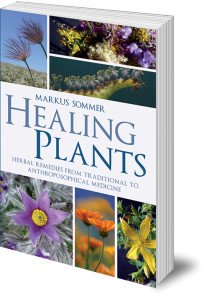From the Kitchen Cupboard to the First Aid Kit: Inside ‘Healing Plants’
by Floris Books • 16 June 2014 • Holistic Health • 0 Comments
 As the days grow longer and sunshine warms our homes and gardens, it’s a wonderful reminder that summer has (hopefully!) arrived. Of course while most of us will enjoy relaxing in the garden and taking some hard-earned holiday days, spare a thought for the poor souls who herald the arrival of summer with runny noses or itchy eyes. Luckily, we have some handy advice for common summer ailments from Dr Markus Sommer, author of our new illustrated health guide Healing Plants.
As the days grow longer and sunshine warms our homes and gardens, it’s a wonderful reminder that summer has (hopefully!) arrived. Of course while most of us will enjoy relaxing in the garden and taking some hard-earned holiday days, spare a thought for the poor souls who herald the arrival of summer with runny noses or itchy eyes. Luckily, we have some handy advice for common summer ailments from Dr Markus Sommer, author of our new illustrated health guide Healing Plants.
Read on to see why Dr Sommer believes that plants like onions and nettles, more commonly found in kitchens, should have a place in your first aid kit too.
Cooling off sunburn
Dr Sommer says: Summer is the season when we yearn for sunshine, warmth and the countryside in order to ‘recharge our batteries’, to get energy for everyday life and the coming winter. Perhaps the ‘dog days’ of August may be the hottest time of the year, but the maximum light lies some time before that. In the northern hemisphere, June 21 is the longest day of the year, with the sun above the horizon for many more hours than in winter. In some places the shortest night of the year is lit up by St John’s fires. This plant, likewise named after John the Baptist, whose feast day is three days after midsummer, begins to open its bright starry flowers at this time.
 St John’s Wort oil (or red oil) can be produced at home or bought. Weleda supplies a particularly concentrated vivid red oil under the name of Hypericum, Flos 25% oil while Hypericum ex herba 5% Oleum (from Wala) is considerably less concentrated. Good results have been reported for these remedies for the post-treatment of mild burns such as sunburn. The anti-inflammatory effects of St John’s Wort are well known.
St John’s Wort oil (or red oil) can be produced at home or bought. Weleda supplies a particularly concentrated vivid red oil under the name of Hypericum, Flos 25% oil while Hypericum ex herba 5% Oleum (from Wala) is considerably less concentrated. Good results have been reported for these remedies for the post-treatment of mild burns such as sunburn. The anti-inflammatory effects of St John’s Wort are well known.
In addition, anyone who has come into contact with the stinging nettle as a child (and who hasn’t?) may not have found it very pleasant, but will have learned to respect this plant. Nettle is used as an alcoholic extract in remedies for burns and scalds. Combudoron (from Weleda) consists mainly of a nettle extract and a small amount of arnica essence; Wala’s Burn Lotion and Wound and Burns Gel are similar, but also contain some additional potentised substances. For large-scale skin damage from sunburn, diluted Burn Lotion or Combudoron can also be sprayed onto the skin. One option is to obtain an empty bottle with a spray top from the chemist and fill this with the diluted solution. The reddened skin can be sprayed several times a day, which generally quickly provides relief.
Take the sting out of insect bites
Dr Sommer says: It is no surprise that the onion has long been a highly prized medicinal and culinary plant. While the onion can bring the benefits of warmth, it can also act as an anti-inflammatory. In particular, in the case of bee stings, it can be observed that after carefully removing the sting from the skin using a pair of tweezers, the swelling and pain quickly subside if a newly cut and lightly crushed onion is placed on the affected area. It can be beneficial to use a new onion after 10–15 minutes. The effect is equally good for wasp stings.
Soothing hayfever
Dr Sommer says: In homeopathy, potentised onion is used under the name of Cepa. The corresponding preparation made by the anthroposophical pharmaceutical company Wala has the complicated but botanically correct name of Allium cepa e bulbo (‘e bulbo’ meaning that the medicine is obtained from the bulb and not from other parts of the plant). I almost always use the globules in potencies of D3 or D6. For a runny nose from hayfever, that makes the area around the nose painful, this remedy can be very helpful if 5 globules are taken hourly and allowed to dissolve slowly in the mouth or under the tongue. In most cases any accompanying irritation of the eyes also improves.
About Healing Plants
 Rosemary, mint and onions are commonly found in kitchens, but physician Markus Sommer argues that cooking only makes use of one aspect of plants like these. In this illustrated, readable book he vividly describes their full characteristics, helping the reader to understand their true nature.
Rosemary, mint and onions are commonly found in kitchens, but physician Markus Sommer argues that cooking only makes use of one aspect of plants like these. In this illustrated, readable book he vividly describes their full characteristics, helping the reader to understand their true nature.
Dr Sommer discusses the properties of over thirty plants, demonstrating the deep connection between the character of the plant and the nature of the conditions they can cure or alleviate. More than just a simple guide to herbal remedies, this book lifts the lid on the powerful secrets of the plant world.
You can also see more of our holistic health titles at florisbooks.co.uk.
Disclaimer: Please note that the author and the publisher disclaim any warranty of fitness for a particular purpose and warn that readers should not rely on the content above as a substitute for conventional medical treatment. The applications and case studies described in this blog and the book cannot replace the advice and treatment of a medical specialist. For a correct diagnosis and appropriate treatment in the case of health problems, or suspected or existing disease, you should always seek the advice of your doctor/physician.